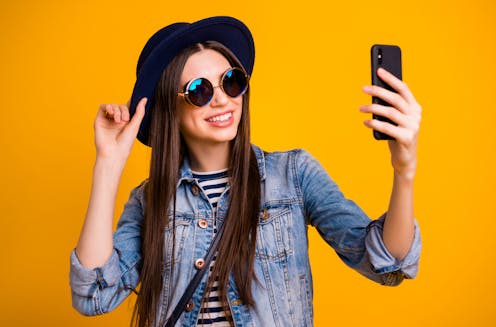'Influencer' is now a popular career choice for young people – here's what you should know about the creator economy's dark side
- Written by Nina Willment, Research Associate, Department of Geography, University of York

A 2019 poll[1] found that children would rather be YouTubers than astronauts. It made headlines and led to plenty of grumbling about “kids these days”. But it’s not surprising that young people – up to 1.3 million[2] in the UK – want to make their income by creating social media content.
The global influencer market was estimated to be worth $13.8 billion (£11.2 billion)[3] in 2021. Individual influencers such as Zoella and Deliciously Ella are worth around £4.7 million and £2.5 million, respectively[4]. Some 300,000 people aged 18-26 are already using[5] content creation as their sole income source.
The lifestyles we see advertised on social media are enticing, but is influencing a viable career path? Underneath the glossy exterior lies precarious income, pay inequality based on sex, race and disability, and mental health issues. In my research[6] with travel influencers and content creators, I have observed these impacts, which young people hoping to become influencers should be aware of.
The DCMS report also noted a “pervasive lack of employment support and protection”. Most influencers are self-employed, often experiencing inconsistent income and a lack of protection that comes with permanent employment – such as entitlement to sick pay and holiday.
The risks of self-employment are exacerbated in the influencer industry by an absence of industry standards and little pay transparency. Influencers are often forced to assess their own value and determine fees for their work. As a result, content creators often undervalue their own creative labour, and many end up working for free.
Power to the platforms
Influencers are also often at the mercy of algorithms – the behind-the-scenes computer programs that determine which posts are shown, in which order, to users. Platforms share little detail about their algorithms, yet they ultimately determine who and what gains visibility (and influence) on social media.
In her work with Instagram influencers[17], algorithms expert Kelley Cotter highlights how the pursuit of influence becomes “a game of visibility”. Influencers interact with the platform (and its algorithm) in ways which they hope will be rewarded with visibility. In my research, I found that influencers shared increasingly intimate and personal moments of their lives, posting relentlessly in a bid to stay relevant.
The threat of invisibility is a constant source of insecurity for influencers, who are under constant pressure to feed platforms with content. If they don’t, they may be “punished” by the algorithm – having posts hidden or displayed lower down on search results.
Mental health crisis
Constant online presence ultimately leads to one of the most pervasive issues of the influencer industry: mental health concerns. Influencers can connect to their platform workspaces and audience at any time of day or night – for many, there is no longer a clear separation between work and life[18]. Coupled with the fear of losing visibility, this can lead to influencers working excessively and facing mental health issues such as burnout.
Online visibility also places content creators at risk of significant online abuse –- both in relation to how they look or what they do (or don’t post), but also negative perceptions of influencing as a career. The potential of online abuse can lead to mental and physical health issues[19], including depression, anxiety, body dysmorphia and eating disorders.
Although becoming an influencer may look appealing to more and more people, the industry’s dark underside needs to be made visible and improved through enhanced employment regulation and industry-led cultural change.
If you are struggling or feel you could benefit from mental health support, please speak to your GP, and/or try contacting supportive organisations such as The Seasonal Affective Disorders Association[20], The Samaritans[21] or Campaign Against Living Miserably[22] (CALM). There is also information on wellbeing and support via the NHS website[23].
References
- ^ 2019 poll (www.independent.co.uk)
- ^ up to 1.3 million (justentrepreneurs.co.uk)
- ^ $13.8 billion (£11.2 billion) (www.statista.com)
- ^ £4.7 million and £2.5 million, respectively (metro.co.uk)
- ^ already using (justentrepreneurs.co.uk)
- ^ my research (pure.royalholloway.ac.uk)
- ^ This article is part of Quarter Life (theconversation.com)
- ^ Online dating fatigue – why some people are turning to face-to-face apps first (theconversation.com)
- ^ Four ways you can design social media posts to combat health misinformation (theconversation.com)
- ^ The last two recessions hit young people hardest – here’s how you can protect yourself for the next one (theconversation.com)
- ^ saying (www.youtube.com)
- ^ (Not) Getting Paid To Do What You Love (yalebooks.yale.edu)
- ^ April 2022 report (committees.parliament.uk)
- ^ a 2020 study from MSL group (mslgroup.com)
- ^ Influencer Pay Gap (www.instagram.com)
- ^ Rawpixel.com / Shutterstock (www.shutterstock.com)
- ^ Instagram influencers (journals.sagepub.com)
- ^ no longer a clear separation between work and life (link.springer.com)
- ^ lead to mental and physical health issues (www.theguardian.com)
- ^ The Seasonal Affective Disorders Association (www.sada.org.uk)
- ^ The Samaritans (www.samaritans.org)
- ^ Campaign Against Living Miserably (www.thecalmzone.net)
- ^ NHS website (www.nhs.uk)







